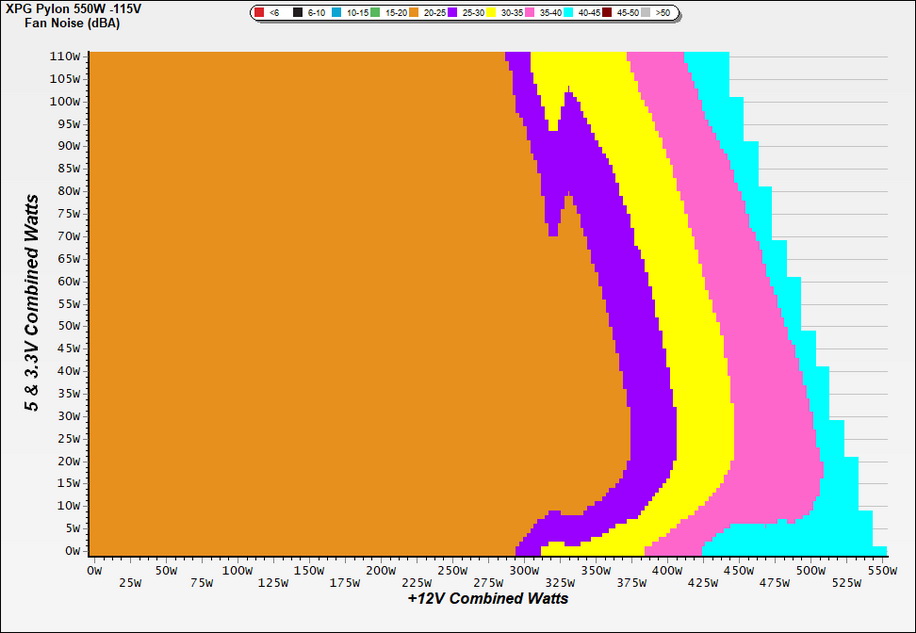Why you can trust Tom's Hardware
To learn more about our PSU tests and methodology, please check out How We Test Power Supply Units.
Primary Rails And 5VSB Load Regulation
Tight regulation is an important consideration every time we review a power supply because it facilitates constant voltage levels despite varying loads. Tight load regulation also, among other factors, improves the system’s stability, especially under overclocked conditions. At the same time, it applies less stress to the DC-DC converters that many system components utilize.
The following charts show the main rails' voltage values recorded between a range of 40W up to the PSU's maximum specified load, along with the deviation (in percent).
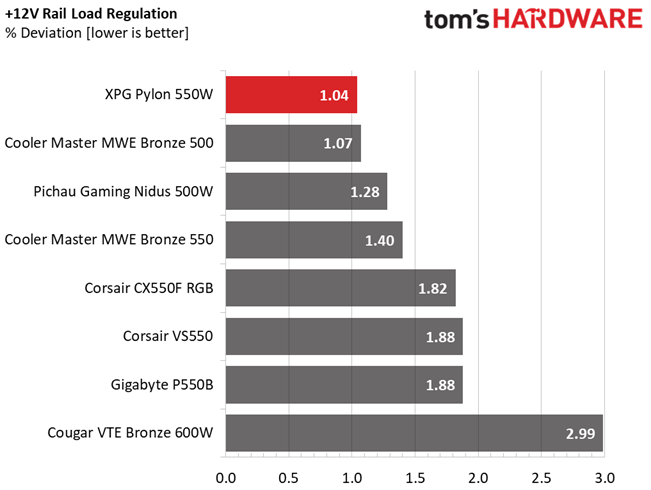
Results 1-8: Load Regulation



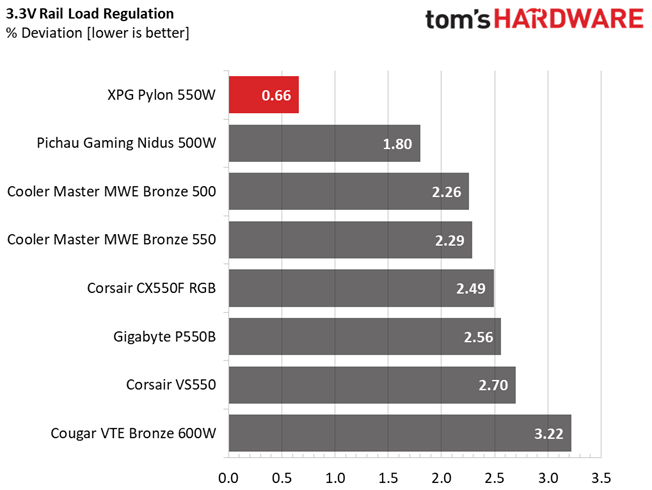



Load regulation is tight on all rails. CWT's work is no less impressive in this affordable platform.
Hold-Up Time

Results 9-12: Hold-Up Time



Put simply, hold-up time is the amount of time that the system can continue to run without shutting down or rebooting during a power interruption. The XPG Pylon 550W's hold-up time doesn't reach 17ms, instead hitting more average numbers when compared to similar units. That's probably because the bulk cap can notably increase the price in cheaper PSUs, so OEMs tend to use smaller capacity bulk caps in units like these.
Inrush Current
Inrush current, or switch-on surge, refers to the maximum, instantaneous input current drawn by an electrical device when it is first turned on. A large enough inrush current can cause circuit breakers and fuses to trip. It can also damage switches, relays, and bridge rectifiers. As a result, the lower the inrush current a PSU has right as you turn it on, the better.

Results 13-14: Inrush Current

The XPH Pylon 550W's inrush current differs depending on your region's electricity standard. While its inrush current with 115V is low, the inrush current for 230V input is on the high side.
Get Tom's Hardware's best news and in-depth reviews, straight to your inbox.
Leakage Current
Leakage current is the unwanted transfer of energy from one circuit to another. In power supplies, it is the current flowing from the primary side to the ground or the chassis, which in the majority of cases is connected to the ground. For measuring leakage current, we use a GW Instek GPT-9904 electrical safety tester instrument.
The leakage current test is conducted at 110% of the DUT's rated voltage input (so for a 230-240V device, we conduct the test with 253-264V input). The maximum acceptable limit of a leakage current is 3.5 mA and it is defined by the IEC-60950-1 regulation, ensuring that the current is low and will not harm any person coming in contact with the power supply's chassis.

Leakage current on the XPG Pylon 550W is higher than competing offerings, but still at low levels.
10-110% Load Tests
These tests reveal the PSU's load regulation and efficiency levels under high ambient temperatures. They also show how the fan speed profile behaves under increased operating temperatures.
| Test # | 12V | 5V | 3.3V | 5VSB | DC/AC (Watts) | Efficiency | Fan Speed (RPM) | PSU Noise (dB[A]) | Temps (In/Out) | PF/AC Volts |
| 1 | 2.727A | 1.983A | 1.992A | 0.988A | 54.960 | 82.331% | 864 | 22.1 | 35.50°C | 0.963 |
| 12.231V | 5.045V | 3.313V | 5.063V | 66.755 | 40.13°C | 115.12V | ||||
| 2 | 6.476A | 2.976A | 2.991A | 1.188A | 110.031 | 86.325% | 866 | 22.0 | 35.86°C | 0.981 |
| 12.218V | 5.043V | 3.310V | 5.050V | 127.462 | 41.37°C | 115.09V | ||||
| 3 | 10.567A | 3.473A | 3.491A | 1.390A | 165.028 | 87.543% | 872 | 21.8 | 36.45°C | 0.987 |
| 12.205V | 5.041V | 3.308V | 5.038V | 188.511 | 42.77°C | 115.09V | ||||
| 4 | 14.666A | 3.970A | 3.995A | 1.592A | 220.034 | 87.763% | 877 | 21.8 | 36.50°C | 0.990 |
| 12.193V | 5.039V | 3.305V | 5.027V | 250.714 | 43.53°C | 115.09V | ||||
| 5 | 18.434A | 4.966A | 4.998A | 1.796A | 275.029 | 87.216% | 882 | 22.1 | 37.23°C | 0.992 |
| 12.179V | 5.036V | 3.303V | 5.014V | 315.344 | 45.00°C | 115.11V | ||||
| 6 | 22.210A | 5.958A | 6.000A | 2.000A | 330.019 | 86.546% | 888 | 23.1 | 37.40°C | 0.994 |
| 12.166V | 5.036V | 3.301V | 5.001V | 381.323 | 45.83°C | 115.09V | ||||
| 7 | 26.004A | 6.950A | 7.004A | 2.207A | 385.104 | 85.506% | 1075 | 27.4 | 38.48°C | 0.994 |
| 12.152V | 5.035V | 3.299V | 4.986V | 450.385 | 47.94°C | 115.10V | ||||
| 8 | 29.801A | 7.952A | 8.009A | 2.414A | 440.109 | 84.338% | 1399 | 34.8 | 38.86°C | 0.994 |
| 12.137V | 5.032V | 3.296V | 4.972V | 521.842 | 48.82°C | 115.13V | ||||
| 9 | 33.996A | 8.453A | 8.499A | 2.418A | 494.608 | 83.356% | 1745 | 40.7 | 39.09°C | 0.994 |
| 12.122V | 5.029V | 3.294V | 4.964V | 593.370 | 49.80°C | 115.10V | ||||
| 10 | 38.198A | 8.956A | 9.022A | 2.523A | 549.716 | 82.250% | 2084 | 45.4 | 39.86°C | 0.994 |
| 12.108V | 5.026V | 3.292V | 4.955V | 668.347 | 51.18°C | 115.13V | ||||
| 11 | 42.810A | 8.959A | 9.026A | 2.527A | 604.954 | 81.144% | 2340 | 46.5 | 40.05°C | 0.994 |
| 12.094V | 5.024V | 3.290V | 4.948V | 745.528 | 52.68°C | 115.11V | ||||
| CL1 | 0.117A | 13.000A | 12.997A | 0.000A | 109.891 | 80.183% | 904 | 22.8 | 37.82°C | 0.982 |
| 12.211V | 5.044V | 3.300V | 5.046V | 137.050 | 45.11°C | 115.16V | ||||
| CL2 | 45.520A | 0.999A | 1.001A | 1.000A | 564.530 | 82.962% | 2073 | 45.1 | 39.52°C | 0.994 |
| 12.109V | 5.030V | 3.299V | 5.001V | 680.468 | 51.51°C | 115.09V |
The PSU doesn't have a problem delivering full load under high operating temperatures. As you can see in the table above, we pushed it hard, but it didn't give us any trouble. Moreover, the PF readings are high even at lower loads.
20-80W Load Tests
In these tests, we measure a PSU's efficiency at loads significantly lower than 10% of its maximum capacity (which is the lowest load the 80 PLUS standard measures). This is important for representing when a PC is idle with power-saving features turned on.
| Test # | 12V | 5V | 3.3V | 5VSB | DC/AC (Watts) | Efficiency | Fan Speed (RPM) | PSU Noise (dB[A]) | PF/AC Volts |
| 1 | 1.213A | 0.493A | 0.498A | 0.197A | 19.988 | 71.203% | 855 | 21.7 | 0.899 |
| 12.239V | 5.048V | 3.316V | 5.086V | 28.072 | 115.12V | ||||
| 2 | 2.426A | 0.991A | 0.994A | 0.394A | 39.978 | 80.160% | 859 | 21.8 | 0.949 |
| 12.235V | 5.046V | 3.314V | 5.079V | 49.873 | 115.10V | ||||
| 3 | 3.643A | 1.487A | 1.493A | 0.592A | 60.007 | 83.790% | 862 | 22.0 | 0.965 |
| 12.231V | 5.045V | 3.313V | 5.071V | 71.616 | 115.09V | ||||
| 4 | 4.855A | 1.983A | 1.992A | 0.790A | 79.957 | 85.292% | 864 | 22.1 | 0.975 |
| 12.226V | 5.044V | 3.312V | 5.064V | 93.745 | 115.11V |
The XPG Pylon 550W has acceptably but not astoundingly high efficiency levels under light loads, and its fan's noise is kept suitably low.
2% or 10W Load Test
Intel has raised the ante on efficiency levels under ultra-light loads. Starting in July 2020, the ATX spec began to require 70% and higher efficiency with 115V input. We test this by applying a 10W load for PSUs with 500W and lower capacities, while for stronger units like this one, we dial 2% of their max-rated-capacity.
| Test # | 12V | 5V | 3.3V | 5VSB | DC/AC (Watts) | Efficiency | Fan Speed (RPM) | PSU Noise (dB[A]) | PF/AC Volts |
| 1 | 0.744A | 0.218A | 0.217A | 0.041A | 11.137 | 62.839% | 827 | 21.0 | 0.833 |
| 12.241V | 5.048V | 3.318V | 5.092V | 17.723 | 115.16V |
The XPG Pylon 550W's efficiency is higher than 60% at light loads, but not quite 70%. Still, that's a very high threshold for Bronze certified units.
Efficiency & Power Factor
We also plotted a chart showing the PSU's efficiency at low loads and at loads from 10% to 110% of its maximum rated capacity. The higher a PSU’s efficiency, the less energy gets wasted, leading to a reduced carbon footprint and lower electricity bills. The same goes for Power Factor.
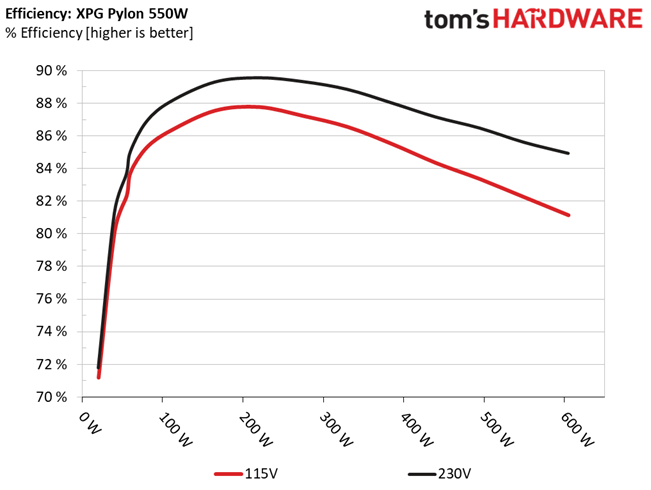
Results 15-18: Efficiency
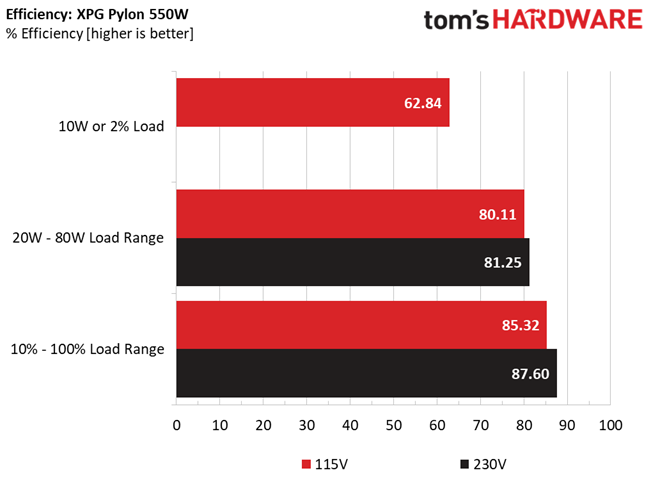



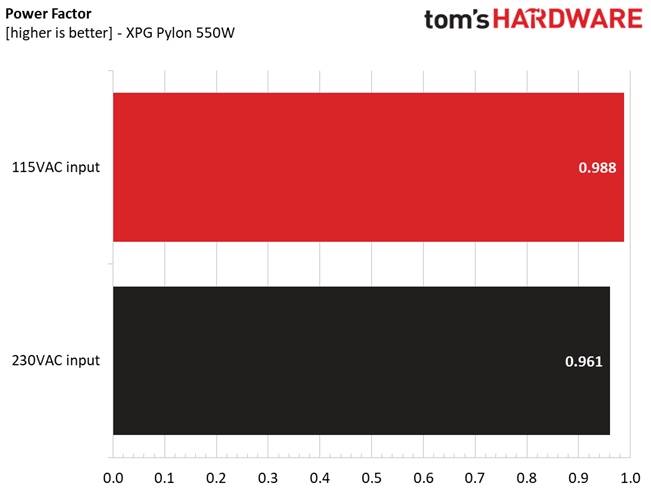
The XPG Pylon 500W's efficiency with normal loads is satisfactory enough, but it really shines at light and super-light loads.
5VSB Efficiency
| Test # | 5VSB | DC/AC (Watts) | Efficiency | PF/AC Volts |
| 1 | 0.100A | 0.509 | 77.473% | 0.074 |
| 5.092V | 0.657 | 115.16V | ||
| 2 | 0.250A | 1.273 | 80.265% | 0.163 |
| 5.089V | 1.586 | 115.15V | ||
| 3 | 0.550A | 2.797 | 81.426% | 0.277 |
| 5.083V | 3.435 | 115.15V | ||
| 4 | 1.000A | 5.075 | 79.396% | 0.363 |
| 5.074V | 6.392 | 115.15V | ||
| 5 | 1.500A | 7.596 | 79.332% | 0.414 |
| 5.063V | 9.575 | 115.12V | ||
| 6 | 2.500A | 12.610 | 77.078% | 0.473 |
| 5.043V | 16.360 | 115.12V |

Results 19-20: 5VSB Efficiency
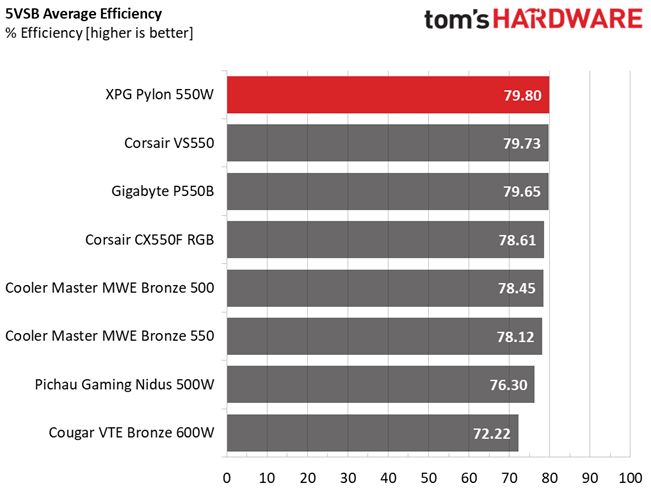
Continuing the XPG Pylon 550W's trend of general high efficiency, the 5VSB rail is highly efficient.
Power Consumption In Idle And Standby
| Mode | 12V | 5V | 3.3V | 5VSB | Watts | PF/AC Volts |
| Idle | 12.243V | 5.047V | 3.318V | 5.095V | 4.488 | 0.422 |
| 115.2V | ||||||
| Standby | 0.037 | 0.004 | ||||
| 115.2V |

Results 21-22: Vampire Power
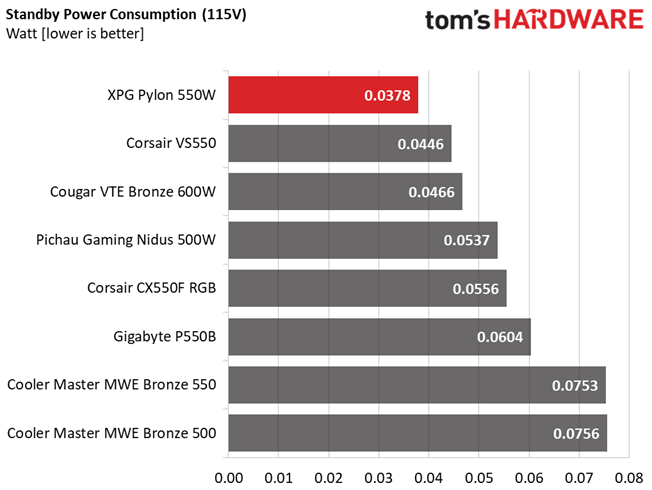
Vampire power is low with both voltage inputs.
Fan RPM, Delta Temperature, And Output Noise
All results are obtained between an ambient temperature of 37 to 47 degrees Celsius (98.6 to 116.6 degrees Fahrenheit).
The fan speed profile is configured well, given the unit's efficiency levels. Under high operating temperatures, the fan's speed is high, to handle the increased thermal loads effectively. But it also know when to stay quiet.
The following noise results were obtained at 30 to 32 degrees Celsius (86 to 89.6 degrees Fahrenheit) ambient temperature.
The XPG Pylon 550W lacks passive operation, but this is not a problem as the fan spins at low speeds at light and mid loads. The fan's noise enters the 40-45 dBA range once the load at 12V exceeds 425W. Under normal ambient temperatures, the fan profile could be more relaxed, especially at high loads.
MORE: Best Power Supplies
MORE: How We Test Power Supplies
MORE: All Power Supply Content
Current page: Load Regulation, Hold-Up Time, Inrush & Leakage Current, Efficiency and Noise
Prev Page Specifications and Part Analysis Next Page Protection Features, DC Power Sequencing, Cross-Load Tests and Infrared Images
Aris Mpitziopoulos is a contributing editor at Tom's Hardware, covering PSUs.
-
NightHawkRMX Given the transient response, I don't know how well this unit would take a high end GPU, but realistically you shouldn't be pairing a 3090 or something with a 550w PSU anyhow.Reply
Right now the XPG Pylon 550w is about $70, the same cost as a CX550 right now. I wish the XPG had a longer warranty, but it is some good competition.





